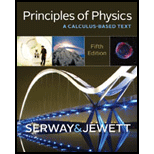
Principles of Physics: A Calculus-Based Text
5th Edition
ISBN: 9781133104261
Author: Raymond A. Serway, John W. Jewett
Publisher: Cengage Learning
expand_more
expand_more
format_list_bulleted
Question
Chapter 28, Problem 39P
(a)
To determine
The minimum uncertainty in the component of the duck’s velocity parallel to the pond’s width.
(b)
To determine
The uncertainty in the ducks position after a time interval of
Expert Solution & Answer
Trending nowThis is a popular solution!

Students have asked these similar questions
Consider a rubber rod that has been rubbed with fur to give the rod a net negative charge, and a glass rod that has been rubbed with silk to give it a net positive charge. After being charged by contact by the fur and silk...?
a. Both rods have less mass
b. the rubber rod has more mass and the glass rod has less mass
c. both rods have more mass
d. the masses of both rods are unchanged
e. the rubber rod has less mass and the glass rod has mroe mass
8) 9)
10)
11)
12)
13)
14)
15)
Chapter 28 Solutions
Principles of Physics: A Calculus-Based Text
Ch. 28.1 - Prob. 28.1QQCh. 28.2 - Prob. 28.2QQCh. 28.2 - Prob. 28.3QQCh. 28.2 - Prob. 28.4QQCh. 28.5 - Prob. 28.5QQCh. 28.5 - Prob. 28.6QQCh. 28.6 - Prob. 28.7QQCh. 28.10 - Prob. 28.8QQCh. 28.10 - Prob. 28.9QQCh. 28.13 - Prob. 28.10QQ
Ch. 28 - Prob. 1OQCh. 28 - Prob. 2OQCh. 28 - Prob. 3OQCh. 28 - Prob. 4OQCh. 28 - Prob. 5OQCh. 28 - Prob. 6OQCh. 28 - Prob. 7OQCh. 28 - Prob. 8OQCh. 28 - Prob. 9OQCh. 28 - Prob. 10OQCh. 28 - Prob. 11OQCh. 28 - Prob. 12OQCh. 28 - Prob. 13OQCh. 28 - Prob. 14OQCh. 28 - Prob. 15OQCh. 28 - Prob. 16OQCh. 28 - Prob. 17OQCh. 28 - Prob. 18OQCh. 28 - Prob. 1CQCh. 28 - Prob. 2CQCh. 28 - Prob. 3CQCh. 28 - Prob. 4CQCh. 28 - Prob. 5CQCh. 28 - Prob. 6CQCh. 28 - Prob. 7CQCh. 28 - Prob. 8CQCh. 28 - Prob. 9CQCh. 28 - Prob. 10CQCh. 28 - Prob. 11CQCh. 28 - Prob. 12CQCh. 28 - Prob. 13CQCh. 28 - Prob. 14CQCh. 28 - Prob. 15CQCh. 28 - Prob. 16CQCh. 28 - Prob. 17CQCh. 28 - Prob. 18CQCh. 28 - Prob. 19CQCh. 28 - Prob. 20CQCh. 28 - Prob. 1PCh. 28 - Prob. 2PCh. 28 - Prob. 3PCh. 28 - Prob. 4PCh. 28 - Prob. 6PCh. 28 - Prob. 7PCh. 28 - Prob. 8PCh. 28 - Prob. 9PCh. 28 - Prob. 10PCh. 28 - Prob. 11PCh. 28 - Prob. 13PCh. 28 - Prob. 14PCh. 28 - Prob. 15PCh. 28 - Prob. 16PCh. 28 - Prob. 17PCh. 28 - Prob. 18PCh. 28 - Prob. 19PCh. 28 - Prob. 20PCh. 28 - Prob. 21PCh. 28 - Prob. 22PCh. 28 - Prob. 23PCh. 28 - Prob. 24PCh. 28 - Prob. 25PCh. 28 - Prob. 26PCh. 28 - Prob. 27PCh. 28 - Prob. 29PCh. 28 - Prob. 30PCh. 28 - Prob. 31PCh. 28 - Prob. 32PCh. 28 - Prob. 33PCh. 28 - Prob. 34PCh. 28 - Prob. 35PCh. 28 - Prob. 36PCh. 28 - Prob. 37PCh. 28 - Prob. 38PCh. 28 - Prob. 39PCh. 28 - Prob. 40PCh. 28 - Prob. 41PCh. 28 - Prob. 42PCh. 28 - Prob. 43PCh. 28 - Prob. 44PCh. 28 - Prob. 45PCh. 28 - Prob. 46PCh. 28 - Prob. 47PCh. 28 - Prob. 48PCh. 28 - Prob. 49PCh. 28 - Prob. 50PCh. 28 - Prob. 51PCh. 28 - Prob. 52PCh. 28 - Prob. 53PCh. 28 - Prob. 54PCh. 28 - Prob. 55PCh. 28 - Prob. 56PCh. 28 - Prob. 57PCh. 28 - Prob. 58PCh. 28 - Prob. 59PCh. 28 - Prob. 60PCh. 28 - Prob. 61PCh. 28 - Prob. 62PCh. 28 - Prob. 63PCh. 28 - Prob. 64PCh. 28 - Prob. 65PCh. 28 - Prob. 66PCh. 28 - Prob. 67PCh. 28 - Prob. 68PCh. 28 - Prob. 69PCh. 28 - Prob. 70PCh. 28 - Prob. 71PCh. 28 - Prob. 72PCh. 28 - Prob. 73PCh. 28 - Prob. 74P
Knowledge Booster
Similar questions
- Mick and Rick are twins born on Earth in the year 2175. Rick grows up to be an Earth-bound robotics technician while Mick becomes an intergalactic astronaut. Mick leaves the Earth on his first space mission in the year 2200 and travels, according to his clock, for 10 years at a speed of 0.75c. Unfortunately, at this point in his journey, the structure of his ship undergoes mechanical breakdown and the ship explodes. How old is Rick when his brother dies?arrow_forwardHi, I have canceled, why did you charge me again?arrow_forwardNo chatgpt pls will upvotearrow_forward
arrow_back_ios
SEE MORE QUESTIONS
arrow_forward_ios
Recommended textbooks for you
 Principles of Physics: A Calculus-Based TextPhysicsISBN:9781133104261Author:Raymond A. Serway, John W. JewettPublisher:Cengage Learning
Principles of Physics: A Calculus-Based TextPhysicsISBN:9781133104261Author:Raymond A. Serway, John W. JewettPublisher:Cengage Learning Modern PhysicsPhysicsISBN:9781111794378Author:Raymond A. Serway, Clement J. Moses, Curt A. MoyerPublisher:Cengage Learning
Modern PhysicsPhysicsISBN:9781111794378Author:Raymond A. Serway, Clement J. Moses, Curt A. MoyerPublisher:Cengage Learning University Physics Volume 3PhysicsISBN:9781938168185Author:William Moebs, Jeff SannyPublisher:OpenStax
University Physics Volume 3PhysicsISBN:9781938168185Author:William Moebs, Jeff SannyPublisher:OpenStax College PhysicsPhysicsISBN:9781938168000Author:Paul Peter Urone, Roger HinrichsPublisher:OpenStax College
College PhysicsPhysicsISBN:9781938168000Author:Paul Peter Urone, Roger HinrichsPublisher:OpenStax College University Physics Volume 1PhysicsISBN:9781938168277Author:William Moebs, Samuel J. Ling, Jeff SannyPublisher:OpenStax - Rice University
University Physics Volume 1PhysicsISBN:9781938168277Author:William Moebs, Samuel J. Ling, Jeff SannyPublisher:OpenStax - Rice University Physics for Scientists and Engineers: Foundations...PhysicsISBN:9781133939146Author:Katz, Debora M.Publisher:Cengage Learning
Physics for Scientists and Engineers: Foundations...PhysicsISBN:9781133939146Author:Katz, Debora M.Publisher:Cengage Learning

Principles of Physics: A Calculus-Based Text
Physics
ISBN:9781133104261
Author:Raymond A. Serway, John W. Jewett
Publisher:Cengage Learning

Modern Physics
Physics
ISBN:9781111794378
Author:Raymond A. Serway, Clement J. Moses, Curt A. Moyer
Publisher:Cengage Learning

University Physics Volume 3
Physics
ISBN:9781938168185
Author:William Moebs, Jeff Sanny
Publisher:OpenStax

College Physics
Physics
ISBN:9781938168000
Author:Paul Peter Urone, Roger Hinrichs
Publisher:OpenStax College

University Physics Volume 1
Physics
ISBN:9781938168277
Author:William Moebs, Samuel J. Ling, Jeff Sanny
Publisher:OpenStax - Rice University

Physics for Scientists and Engineers: Foundations...
Physics
ISBN:9781133939146
Author:Katz, Debora M.
Publisher:Cengage Learning